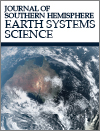
Journal of Southern Hemisphere Earth Systems Science
Volume 71 Number 2 2021
We assessed the ability of ACCESS-S1 to predict variations in extreme weekly rainfall over Australia when the Madden-Julian Oscillation (MJO) is strong. The ability of ACCESS-S1 to represent these rainfall variations and to predict the MJO up to four weeks ahead, leads to improved prediction across much of Australia when the MJO is strong during spring and summer. These results are useful for when the MJO is forecast to be strong in regions where it influences extreme rainfall.
ES21001 Abstract | ES21001 Full Text | ES21001PDF (12 MB) Open Access Article
The asymmetry of stratospheric circulation in the southern hemisphere (SH) is important for the distribution of the ozone layer, it’s seasonal depletion, and its influence on surface climate. Using a state-of-the-art chemistry climate model, different hypothetical scenarios were simulated to determine the impacts of increasing greenhouse gases (GHGs) and a changing ozone layer on stratospheric asymmetry. It is shown that the asymmetric structure of the SH shifts due to changing ozone concentrations and that increasing GHGs with ozone changes have the largest influence.
ES21002 Abstract | ES21002 Full Text | ES21002PDF (548 KB) | ES21002Supplementary Material (294 KB) Open Access Article
Screen level temperature and humidity data from a high resolution atmospheric regional reanalysis, Bureau of Meteorology Atmospheric high-resolution Regional Reanalysis for Australia (BARRA) is validated against station data for 32 sites across Northern Australia. These data show that the BARRA data is reliable but there are some seasonally and diurnally varying biases. The amplitude of the diurnal cycle of temperature is over-estimated, particularly in the dry (winter) season. Differences in temperature are larger than those of the dew point temperature, and the wet bulb temperature has the least uncertainty. There is a dry bias which is most evident in the dry season.
ES21007 Abstract | ES21007 Full Text | ES21007PDF (598 KB) Open Access Article
ES21011Revisions to the Australian tropical cyclone best track database
 , Gary R. Foley, Johannes L. van Burgel, Blair Trewin
, Gary R. Foley, Johannes L. van Burgel, Blair Trewin  , Andrew D. Burton, Jeffrey Callaghan and Noel E. Davidson
, Andrew D. Burton, Jeffrey Callaghan and Noel E. Davidson
The Australian tropical cyclone best track database, maintained by the Bureau of Meteorology, has records since 1909 of varying quality and completeness. A series of efforts over the past 15 years have made improvements to generate a more consistent dataset that can be used for weather and climate research and other cyclone-related work.
ES21011 Abstract | ES21011 Full Text | ES21011PDF (4 MB) Open Access Article


